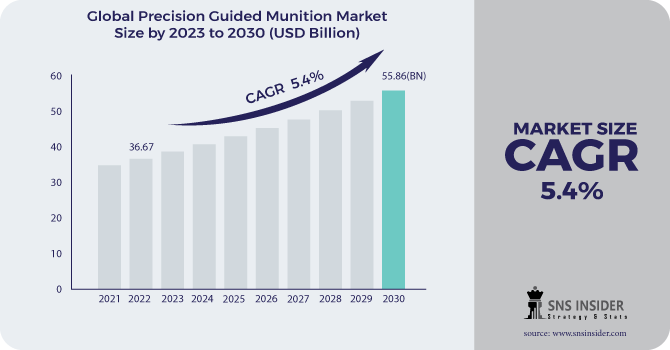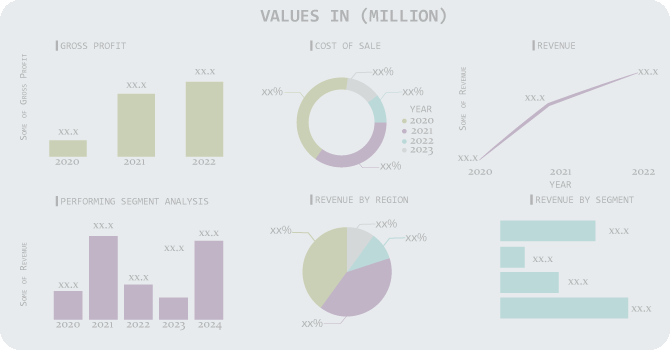Precision Guided Munition Market Report Scope & Overview:
The Precision Guided Munition Market is expected to increase at a CAGR of 5.4% percent from 2023 to 2030, from USD 36.67 billion in 2022 to USD 55.86 billion in 2030.
The precision-guided munition market is predicted to develop as military budgets throughout the world continue to rise, as does the requirement for superior precision-guided munition to fight contemporary conflict beyond the country's borders. Furthermore, the growing number of wars and rising defense spending are two important drivers driving the worldwide market. Various governments, including the United States, China, India, and Russia, are investing considerably in upgrading their armed forces. As a result, several weapon makers are moving their attention to the development of precision-guided munitions. However, Precision guided munitions are shells that have a terminal guiding system for missiles, bombs, or artillery. It incorporates electrical equipment to direct before the effect in the final step. The terminal guiding unit is designed to detect emitted or reflected EMR within its range of view (electromagnetic radiation). Because the impact of explosive weapons decreases with distance due to inverse cube regulation, even minor accuracy improvements allow a target to be attacked with fewer or smaller bombs. Thus, even if some guided bombs go missing, fewer air crews are put in danger, potentially reducing civilian injury and collateral damage.

To get more information on Precision Guided Munition Market - Request Free Sample Report
KEY DRIVERS
-
New technologies and the development of a new generation of air defense systems arrow serve as a key factor in promoting the growth of the precision-led arms industry.
-
This development of arrows furthers the need for protective shields, which may increase the market demand.
-
The upgrading of the new generation of state-of-the-art missiles is a major threat to strategic areas and forums such as naval vessels and airspace.
-
Governments around the world are working hard to improve their low-cost aircraft.
-
precision-guided air defense systems need more technologies such as laser, GPS, INS, radar, etc.
RESTRAINTS
-
In many lands, weapons manufacturers are banned from exporting their products, thus reducing their chances of working with overseas customers.
-
This prevents arms manufacturers from reaching international markets.
-
This has led to strict control over the transfer of technology and weapons to other countries.
-
This feature acts as a barrier to the growth of the precise targeted arms market.
OPPORTUNITIES
-
The development of the new generation of advanced technology is a major threat to strategic areas such as military aircraft and ships.
-
Some of these new developments include nuclear missiles and high-speed missiles.
-
Various countries are developing such advanced weapons that they can defeat advanced air defense systems
-
India and Russia together are building a Brahmas arrow, which is hard to stop with old defensive shields.
CHALLENGES
-
The integration of small arms with precision-guided munitions involves a simpler process than the larger ones.
-
The integration of various electronic devices, sensors, warheads, deadly vehicles, driving systems, and other sub-systems is extremely complex.
-
Difficulty increases in the form of Multiple Independent Re-entry Vehicle missiles with multiple warheads designed for multiple targets.
-
The assembling process is very complex and requires skilled engineers to do the job.
-
These integration problems can serve as a challenge to the growth of this market.
THE IMPACT OF COVID-19
The outbreak of COVID-19 has led to many challenges in the defense industry. Although the industry has not been significantly affected, it is still facing many economic problems after the collapse of COVID-19. Since the beginning of the genocide, the defense industry has been under attack from all over the world. The suspension of private equity, the reduction of defense costs by 2020 worldwide, and the postponement of planned contracts have had a significant impact on the defense industry. Therefore, research and development-related activities on precision-guided weapons have been delayed, due to the testing of other archery technology. In addition, with the decline in the supply of precision-directed weapons supply due to COVID-19, many companies are expected to face production shortages. Thus, it has contributed to the growth of the market.
KEY MARKET SEGMENTATION
By Speed
-
Subsonic
-
Supersonic
-
Hypersonic
By Product
-
Tactical Missiles
-
Guided Rockets
-
Guided Ammunition
-
Loitering Munitions
By Technology
-
Infrared
-
Laser
-
Global Positioning System (GPS)
-
Radar Homing
-
Anti-radiation
By Mode of Operation
-
Autonomous
-
Semi-autonomous
By Launch Platform
-
Land
-
Airborne
-
Naval
.png)
Need any customization research on Precision Guided Munition Market - Enquiry Now
REGIONAL ANALYSIS
The Asia Pacific dominated the global market by 2021 with a budget of more than 31%. The region is expected to continue the same trend of growing in the CAGR which is very fast in the forecast period. China, South Korea, India, North Korea, Pakistan, and Japan are among the biggest players commanding a strategic war. Growing tensions between countries in the region and the need to strengthen defense capabilities are likely to create an environment for precision-guided weapons. Growing tensions between India and Pakistan have led India to strengthen its defensive capabilities by adding advanced arrows that include Prithvi, Agni, Brahmos, and others. Technological advances and cooperation with the foreign defense departments regarding modern military equipment are expected to increase the penetration of targeted weapons.
REGIONAL COVERAGE:
North America
-
USA
-
Canada
-
Mexico
Europe
-
Germany
-
UK
-
France
-
Italy
-
Spain
-
The Netherlands
-
Rest of Europe
Asia-Pacific
-
Japan
-
South Korea
-
China
-
India
-
Australia
-
Rest of Asia-Pacific
The Middle East & Africa
-
Israel
-
UAE
-
South Africa
-
Rest of the Middle East & Africa
Latin America
-
Brazil
-
Argentina
-
Rest of Latin America
KEY PLAYERS
The Key Players are Northrop Grumman Corporation, Elbit Systems Ltd., Israel Aerospace Industries Ltd., KONGSBERG, Raytheon Technologies Corporation, Lockheed Martin Corporation, BAE Systems, Boeing., General Dynamics Corporation, Saab AB & Other Players.
Elbit Systems Ltd-Company Financial Analysis

| Report Attributes | Details |
|---|---|
| Market Size in 2022 | US$ 36.67 Billion |
| Market Size by 2030 | US$ 55.86 Billion |
| CAGR | CAGR of 5.4% From 2023 to 2030 |
| Base Year | 2022 |
| Forecast Period | 2023-2030 |
| Historical Data | 2020-2021 |
| Report Scope & Coverage | Market Size, Segments Analysis, Competitive Landscape, Regional Analysis, DROC & SWOT Analysis, Forecast Outlook |
| Key Segments | • By Speed (Subsonic, Supersonic, and Hypersonic) • By Mode of Operation (Semi-autonomous and Autonomous), Launch Platform (Land, Airborne and Naval) • By Product • By Technology |
| Regional Analysis/Coverage | North America (USA, Canada, Mexico), Europe (Germany, UK, France, Italy, Spain, Netherlands, Rest of Europe), Asia-Pacific (Japan, South Korea, China, India, Australia, Rest of Asia-Pacific), The Middle East & Africa (Israel, UAE, South Africa, Rest of Middle East & Africa), Latin America (Brazil, Argentina, Rest of Latin America) |
| Company Profiles | Northrop Grumman Corporation, Elbit Systems Ltd., Israel Aerospace Industries Ltd., KONGSBERG, Raytheon Technologies Corporation, Lockheed Martin Corporation, BAE Systems, Boeing., General Dynamics Corporation, Saab AB. |
| DRIVERS | • New technologies and the development of a new generation of air defense systems arrow serve as a key factor in promoting the growth of the precision-led arms industry. • This development of arrows furthers the need for protective shields, which may increase the market demand. • The upgrading of the new generation of state-of-the-art missiles is a major threat to strategic areas and forums such as naval vessels and airspace. |
| RESTRAINTS | • In many lands, weapons manufacturers are banned from exporting their products, thus reducing their chances of working with overseas customers. • This prevents arms manufacturers from reaching international markets. • This has led to strict control over the transfer of technology and weapons to other countries. |

